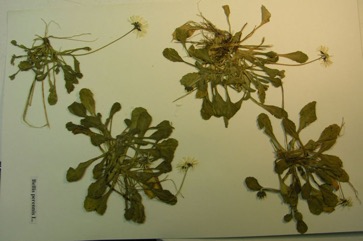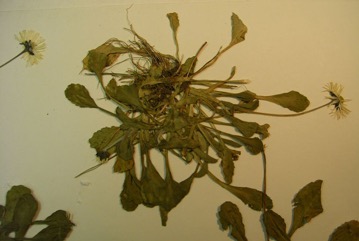Daisy, Lawn Daisy, English Daisy

It is a temperate plant. It is frost hardy. It grows in open spaces and grassland. It can grow in full sun or light shade. It will grow in average soils but they need to be well drained. Soils rich in organic matter are good. It needs a temperature of 10-13°C for germination. It suits hardiness zones 4-10. In the tropics it grows at higher altitudes. It can grow in arid places. Tasmania Herbarium. In Sichuan.
Also known as:
Beyazpapatya, Koyungozu, Margarita, Margheritina, Mindris gvirila, Mya-ta-pwint, Navadna marjetica, Papatya, Parichka, Prstenjak, Sedmikraska obecna
Edible Portion
- Flowers, Leaves, Flowers - tea
Where does Daisy grow?
Found in: Africa, Alaskia, Albania, Algeria, Argentina, Asia, Australia, Austria, Azerbaijan, Azores, Balkans, Belgium, Bosnia, Britain, Bulgaria, Canada, Caucasus, Chile, China, Cyprus, Czech Republic, Denmark, Europe, Falklands, Finland, France, Georgia, Germany, Greece, Hawaii, Hungary, Iceland, Iraq, Ireland, Israel, Italy, Korea, Kurdistan, Luxembourg, Macedonia, Mediterranean, Morocco, Myanmar, Netherlands, New Zealand, North Africa, North America, Norway, Pacific, Poland, Scandinavia, Slovakia, Slovenia, South America, Spain, Sweden, Switzerland, Syria, Tasmania, Turkey, United States, Yugoslavia
Notes: There are about 7-15 Bellis species.
Status: It is foraged and supplied to restaurants in Sweden.
Growing Daisy, Lawn Daisy, English Daisy
Cultivation: Plants are grown from seed. Seedlings can be transplanted. Plants re-seed. Plants can also be grown by division.
Edible Uses: Tender young leaves can be tossed in salads. They are also used as a potherb. They are also used in vegetable soups. The flowers are added to salads. They are also used for herbal tea. The flower buds are used in sandwiches, soups and salads. The flower buds are preserved in vinegar and used as a caper substitute.
Nutrition Info
per 100g edible portion| Edible Part | Energy (kcal) | Protein (g) | Iron (mg) | Vitamin A (ug) | Vitamin c (mg) | Zinc (mg) | % Water |
|---|---|---|---|---|---|---|---|
| Leaves | - | - | - | - | - | - | |
| Flowers | - | - | - | - | - | - |
Daisy, Lawn Daisy, English Daisy Photos


References
Abbet, C., et al, 2014, Ethnobotanical survey on wild alpine food plants in Lower and Central Valais (Switzerland). Journal of Ethnopharmacology 151 (2014) 624–634
Biscotti, N. et al, 2018, The traditional food use of wild vegetables in Apulia (Italy) in the light of Italian ethnobotanical literature. Italian Botanist 5:1-24
Blamey, M and Grey-Wilson, C., 2005, Wild flowers of the Mediterranean. A & C Black London. p 433
Blanco-Salas, J., et al, 2019, Wild Plants Potentially Used in Human Food in the Protected Area “Sierra Grande de Hornachos” of Extremadura (Spain). Sustainability 2019, 11, 456
Bodkin, F., 1991, Encyclopedia Botanica. Cornstalk publishing, p 140
Bremness, L., 1994, Herbs. Collins Eyewitness Handbooks. Harper Collins. p 154
Brown, D., 2002, The Royal Horticultural Society encyclopedia of Herbs and their uses. DK Books. p 142
Burnie, G. (Ed.), 2003, Annuals and Bulbs. The Gardener's Handbooks. Fog City Press. p 125
Cerne, M., 1992, Wild Plants from Slovenia used as Vegetables. Acta Horticulturae 318
Cundall, P., (ed.), 2004, Gardening Australia: flora: the gardener's bible. ABC Books. p 228
Dogan, Y., 2012, Traditionally used wild edible greens in the Aegean Region of Turkey. Acta Societatis Botanicorum Poloniae 81(4): 329-342
Dogan, Y. et al, 2013, Wild Edible Plants sold in the Local Markets of Izmir, Turkey. Pak. J. Bot. 45(S1): 177-184
Ertug, F, Yenen Bitkiler. Resimli Türkiye Florası -I- Flora of Turkey - Ethnobotany supplement
Facciola, S., 1998, Cornucopia 2: a Source Book of Edible Plants. Kampong Publications, p 34
Hedrick, U.P., 1919, (Ed.), Sturtevant's edible plants of the world. p 96
Hibbert, M., 2002, The Aussie Plant Finder 2002, Florilegium. p 42
Irving, M., 2009, The Forager Handbook, A Guide to the Edible Plants of Britain. Ebury Press p 145
Jackes, D. A., Edible Forest Gardens
Joyce, D., 1998, The Garden Plant Selector. Ryland, Peters and Small. p 313
Kizilarslan, C. & Ozhatay, N., 2012, An ethnobotanical study of the useful and edible plants of İzmit. Marmara Pharmaceutical Journal 16: 134-140, 2012.
Koca, I., et al, 2015, Some Wild Edible Plants and Their Dietary Fiber Contents. Pakistan Journal of Nutrition. 14(4): 188-194
Lamp, C & Collet F., 1989, Field Guide to Weeds in Australia. Inkata Press. p 34
Luczaj, L. et al, 2012, Wild food plant use in 21st century Europe: the disappearance of old traditions and the search for new cuisines involving wild edibles. Acta Soc Bot Pol 81(4):359–370
Lukasz, L., 2016, Wild Edible Plants Traditionally Used in Poland.
Luczaj, L. et al, 2017, Comfrey and Buttercup Eaters: Wild Vegetables of the Imereti Region in Western Georgia, Caucasus. Economic Botany, 71(2), 2017, pp. 188–193
Menendez-Baceta, G., et al, 2012, Wild edible plants traditionally gathered in Gorbeialdea (Biscay, Basque Country) Genetic Reources and Crop Evolution 59:1329-1347
Morley, B. & Everard, B., 1970, Wild Flowers of the World. Ebury press. Plate 22
Nedelcheva A., 2013, An ethnobotanical study of wild edible plants in Bulgaria. EurAsian Journal of BioSciences 7, 77-94
Paoletti, M.G., Dreon, A.L., and Lorenzoni, G.G., 1995, Pistic, Traditional Food from Western Friuli, NE Italy. Economic Botany 49(1) pp 26-30
Pieroni, A., 1999, Gathered wild food plants in the Upper Valley of the Serchio River (Garfagnana), Central Italy. Economic Botany 53(3) pp 327-341
Plants for a Future database, The Field, Penpol, Lostwithiel, Cornwall, PL22 0NG, UK. http://www.scs.leeds.ac.uk/pfaf/
Polat, R., et al, 2015, Survey of wild food plants for human consumption in Elazig (Turkey). Indian Journal of Traditional Knowledge. Vol. 1(1): 69-75
Polat, R., et al, 2017, Survey of wild food plants for human consumption in Bingol, (Turkey). Indian Journal of Traditional Knowledge. Vol. 16(3) July 2017, pp. 378-384
Redzic, S. J., 2006, Wild Edible Plants and their Traditional Use in the Human Nutrition in Bosnia-Herzegovina. Ecology of Food and Nutrition, 45:189-232
Redzic, S., 2010, Use of Wild and Semi-Wild Edible Plants in Nutrition and Survival of People in 1430 Days of Siege of Sarajevo during the War in Bosnia and Herzegovina (1992–1995). Coll. Antropol 34 (2010) 2:551-570
Royal Botanic Gardens, Kew (1999). Survey of Economic Plants for Arid and Semi-Arid Lands (SEPASAL) database. Published on the Internet; http://www.rbgkew.org.uk/ceb/sepasal/internet [Accessed 11th April 2011]
Sansanelli, S., et al, 2014, Wild food plants traditionall consumed in the area of Bologna (Emilia Romagna region, Italy). Journal of Ethnobiology and Ethnomedicine 10:69
Schunko, C., et al, 2010, Organic farmers use of wild food plants and fungi in a hilly area in Styria (Austria). Journal of Ethnobiology and Ethnomedicine 6:17
Simkova, K. et al, 2014, Ethnobotanical review of wild edible plants used in the Czech Republic. Journal of Applied Botany and Food Quality 88, 49-67
Sp. pl. 2:886. 1753
Staples, G.W. and Herbst, D.R., 2005, A tropical Garden Flora. Bishop Museum Press, Honolulu, Hawaii. p 167
Tasmanian Herbarium Vascular Plants list p 5
Upson, R., & Lewis R., 2014, Updated Vascular Plant Checklist and Atlas for the Falkland Islands. Falklands Conservation and Kew.